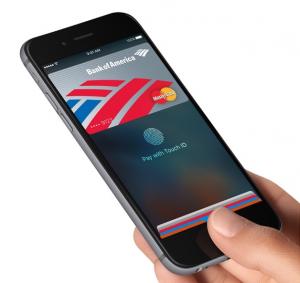Apple Testing Loyalty Feature; Google Expected to Expand Payments for Home Device

NFC TIMES Exclusive – As they struggle with low user adoption of their respective wallets in the U.S., Apple and Google are seeking to add more features, hoping to increase transactions, NFC Times has learned.
Apple, in a closed-door luncheon meeting late last week during the Transact conference and exhibition in Las Vegas, indicated it was beta testing a feature that would make it easier for users to add loyalty applications to Apple’s Wallet, an attendee of the meeting, which was closed to the press, told NFC Times.
Users would be able send links in text messages that could enable the recipients to easily add loyalty applications and possibly gift cards to their Apple wallets or to more quickly download the merchants’ apps to their iPhones, the attendee said. For example, a friend could send a link that includes a Dunkin’ Donuts loyalty program, which the recipient could easily add to his wallet.
Apple during the meeting indicated it was planning other value-added services for Apple Pay for its Apple Wallet, in general, though did not go into details. These include transport applications, something Apple has said many times before.
Overall, its presentation to the luncheon group mainly repeated talking points about Apple Pay that the tech giant has already made public, including during the tech giant’s fiscal second quarter conference call earlier this month. That includes touting global growth figures for Apple Pay transactions for 2016 of 450%, though not releasing the actual base of transactions. Apple also didn’t give market-by-market comparisons with one or two exceptions.
And Apple didn’t mention any growth figures at all in its conference call or during the luncheon meeting for the U.S.
That may be because Apple Pay transactions were believed to be either flat or slightly down in 2016 in the U.S., processors told NFC Times. They estimated that all transactions from NFC wallets in the U.S., including Apple Pay, Android Pay and the NFC interface of Samsung Pay account for around 1% of total retail card transactions, perhaps less.
Google Home Payments Hub?
Android Pay accounts for only a relatively small portion of that 1%, and like the other wallets is planning to add functionality.
Google is expected to announce added features or functionality to Android Pay and other payments this week at its Google I/O developer conference. Among the enhancements for Android Pay is possibly playing a role in expanding the IoT payments capability of Google Home, its voice-directed home assistant, a U.S. payments industry source told NFC Times.
Google is seeking to increase the usefulness of its mobile wallet, which is believed to be running a distant third behind both Samsung Pay and Apple Pay in the U.S. for transactions (including non-NFC payments transactions for Samsung Pay). Google also wants its home voice assistant device to stay competitive with Amazon’s Alexa and Echo.
Google earlier this year already began enabling consumers to buy from online marketplace Google Express through the voice-activated Google Home speaker, powered by its Google Assistant application. The consumers buy via store credit or debit cards accessed by Assistant.
Details are still sketchy, but according to the source, consumers will be able to make more types of purchases through Home. And it might use tokenization, which replaces original PAN numbers with token account numbers, just like Android Pay and other “Pays” wallets do.
“So your Android Pay (wallet) will be able to provision that token into Home devices,” said the source. Then, if your fridge wants to order milk, it can do so and pass the request directly to a processor for a machine-to-machine payment, he said. “It’s not web, it’s not mobile, it’s fridge, or dishwasher,” said the payments industry source. “But more likely, your Google Home device will order for you.”
If true, this would expand the role of the Google Home IoT hub. It would be able to coordinate more payments, with a connection to Android Pay. It would also apparently route purchases for home appliances through Home, although this is not yet confirmed.
Overall, like Apple and Samsung, Google is keen on improving the value proposition of its “Pays” wallet, expanding beyond payments. That includes more loyalty and offers, which Google has been slow to add to Android Pay. That is particularly true using the NFC interface.
Although it purchased the assets of the Softcard joint venture, including its SmartTap technology that enables payments and rewards or offers in a single tap, Google has implemented it only for two to three merchants, including Coca-Cola vending machines and Walgreens retail pharmacies. Walgreens, which also supports its Balance Rewards program through Apple Pay, uses two taps, one for loyalty and one for payment, to complete a transaction.
Parag Ladhawala, business development for Android Pay Partnerships at Google, acknowledged during a panel discussion at Transact that payments is not enough for the wallet.
“The consumer will not do this unless they’re getting something for this,” he said. “So from an Android-based perspective, we're thinking about what else can we do to engage that user; maybe its' location-based offers, getting something because I’m close to a merchant. I don’t want to get something after I’ve gotten into the store.”
If Google does indeed establish a connection between Android Pay and Google Home, users, of course, won’t need to enter the store to make purchases. These would be online transactions, just like they can do with their smartphones and Android Pay for in-app and in-browser payments.
© NFC Times and Forthwrite Media. NFC Times content is for individual use and cannot be copied or distributed without the express permission of the publisher.











